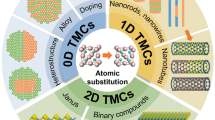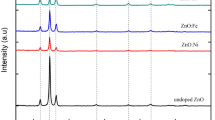Abstract
Anatase TiO2 nanoparticles doped either with Li or Ni have been synthesized via hydrolysis in variable concentrations. Microstructural analysis confirms the high crystallinity of the doped nanoparticles with sizes around 7 nm, while compositional analysis shows low doping below 2% at. Despite the low concentration of dopants, variations in the Raman and Photoluminescence signals were observed in the doped nanoparticles, mainly due to non-stoichiometry and oxygen deficiency promoted by Li or Ni doping. Doping effects associated with Li and Ni were observed by photoelectron spectroscopy and first principle calculations, which associate the appearance of states in the valence band region to oxygen deficiency and Li or Ni doping and lower n-type character induced by Ni doping. Finally, changes in the thermally induced anatase-to-rutile transition (ART) have been also observed in the doped samples, leading to a dopant-promoted faster ART which occurs at lower temperature boosted due to the dopant effect.
Graphical abstract










Similar content being viewed by others
References
Noman MT, Ashraf MA, Ali A (2019) Synthesis and applications of nano-TiO2: a review. Environ Sci Pollut Res 26:3262–3291. https://doi.org/10.1007/s11356-018-3884-z
Zhang Y, Jiang Z, Huang J et al (2015) Titanate and titania nanostructured materials for environmental and energy applications: a review. RSC Adv 5:79479–79510. https://doi.org/10.1039/c5ra11298b
Schneider J, Matsuoka M, Takeuchi M et al (2014) Understanding TiO2 photocatalysis: mechanisms and materials. Chem Rev 114:9919–9986. https://doi.org/10.1021/cr5001892
Madian M, Eychmüller A, Giebeler L (2018) Current advances in TiO2-based nanostructure electrodes for high performance lithium ion batteries. Batteries 4:7. https://doi.org/10.3390/BATTERIES4010007
Liang S, Wang X, Cheng YJ et al (2022) Anatase titanium dioxide as rechargeable ion battery electrode-a chronological review. Energy Storage Mater 45:201–264. https://doi.org/10.1016/J.ENSM.2021.11.023
Zhang J, Zhou P, Liu J, Yu J (2014) New understanding of the difference of photocatalytic activity among anatase, rutile and brookite TiO2. Phys Chem Chem Phys 16:20382–20386. https://doi.org/10.1039/c4cp02201g
Ahmed SA (2017) Ferromagnetism in Cr-, Fe-, and Ni-doped TiO2 samples. J Magn Magn Mater 442:152–157. https://doi.org/10.1016/J.JMMM.2017.06.108
Komaraiah D, Radha E, Kalarikkal N et al (2019) Structural, optical and photoluminescence studies of sol-gel synthesized pure and iron doped TiO2 photocatalysts. Ceram Int 45:25060–25068. https://doi.org/10.1016/J.CERAMINT.2019.03.170
Vásquez GC, Peche-Herrero MA, Maestre D et al (2014) Influence of Fe and Al doping on the stabilization of the anatase phase in TiO2 nanoparticles. J Mater Chem C 2:10377–10385. https://doi.org/10.1039/c4tc02099e
Hanaor DAH, Sorrell CC (2011) Review of the anatase to rutile phase transformation. J Mater Sci 46:855–874. https://doi.org/10.1007/s10853-010-5113-0
Pirsaheb M, Shahmoradi B, Khosravi T et al (2016) Solar degradation of malachite green using nickel-doped TiO2 nanocatalysts. Desalin Water Treat 57:9881–9888. https://doi.org/10.1080/19443994.2015.1033764
Hyun Kim D, Sub Lee K, Kim Y-S et al (2006) Photocatalytic activity of Ni 8 wt%-Doped TiO2 photocatalyst synthesized by mechanical alloying under visible light. J Am Ceram Soc 89:515–518. https://doi.org/10.1111/j.1551-2916.2005.00782.x
Elahifard MR, Ahmadvand S, Mirzanejad A (2018) Effects of Ni-doping on the photo-catalytic activity of TiO2 anatase and rutile: simulation and experiment. Mater Sci Semicond Process 84:10–16. https://doi.org/10.1016/j.mssp.2018.05.001
Chen J, Lu GH, Cao H et al (2008) Ferromagnetic mechanism in Ni-doped anatase TiO2. Appl Phys Lett 93:172504. https://doi.org/10.1063/1.3002291
Balakrishnan M, John R (2021) Impact of Ni metal ion concentration in TiO2 nanoparticles for enhanced photovoltaic performance of dye sensitized solar cell. J Mater Sci Mater Electron 32:5295–5308. https://doi.org/10.1007/S10854-020-05100-0/TABLES/5
Liang Y, Su K, Cao L, Li Z (2019) Lithium doped TiO2 as catalysts for the transesterification of bisphenol-A with dimethyl carbonate. Mol Catal 465:16–23. https://doi.org/10.1016/j.mcat.2018.12.022
Ravishankar TN, Nagaraju G, Dupont J (2016) Photocatalytic activity of Li-doped TiO2 nanoparticles: synthesis via ionic liquid-assisted hydrothermal route. Mater Res Bull 78:103–111. https://doi.org/10.1016/j.materresbull.2016.02.017
Lan C, Luo J, Lan H et al (2018) Enhanced charge extraction of Li-doped TiO2 for efficient thermal-evaporated Sb2S3 thin film solar cells. Materials (Basel) 11:355. https://doi.org/10.3390/ma11030355
Wang YQ, Gu L, Guo YG et al (2012) Rutile-TiO2 nanocoating for a high-rate Li4Ti5O12 anode of a lithium-ion battery. J Am Chem Soc 134:7874–7879. https://doi.org/10.1021/ja301266w
Vázquez-López A, García-Carrión M, Hall E et al (2021) Hybrid materials and nanoparticles for hybrid silicon solar cells and Li-ion batteries. J Energy Power Technol 3:1–1. https://doi.org/10.21926/JEPT.2102020
Vázquez-López A, Maestre D, Ramírez-Castellanos J et al (2020) Influence of doping and controlled Sn charge state on the properties and performance of SnO2 nanoparticles as anodes in Li-ion batteries. J Phys Chem C 124:18490–18501. https://doi.org/10.1021/acs.jpcc.0c06318
Nyamukamba P, Okoh O, Mungondori H, et al (2018) Synthetic methods for titanium dioxide nanoparticles: a review. In: Yang D (ed) Titanium dioxide - material for a sustainable environment, IntechOpen. https://doi.org/10.5772/intechopen.70290
Zangrando M, Finazzi M, Paolucci G et al (2001) BACH, the beamline for advanced dichroic and scattering experiments at ELETTRA. Rev Sci Instrum 72:1313–1319. https://doi.org/10.1063/1.1334626
Zangrando M, Zacchigria M, Finazzi M et al (2004) Polarized high-brilliance and high-resolution soft X-ray source at ELETTRA: the performance of beamline BACH. Rev Sci Instrum 75:31–36. https://doi.org/10.1063/1.1634355
Oku M, Wagatsuma K, Kohiki S (1999) Ti 2p and Ti 3p X-ray photoelectron spectra for TiO2, SrTiO3 and BaTiO3. Phys Chem Chem Phys 1:5327–5331. https://doi.org/10.1039/a907161j
Ohsaka T, Izumi F, Fujiki Y (1978) Raman spectrum of anatase, TiO2. J Raman Spectrosc 7:321–324. https://doi.org/10.1002/jrs.1250070606
Zhang WF, He YL, Zhang MS et al (2000) Raman scattering study on anatase TiO2 nanocrystals. J Phys D Appl Phys 33:912–916. https://doi.org/10.1088/0022-3727/33/8/305
Vázquez-López A, Yaseen A, Maestre D et al (2020) Improved silicon surface passivation by hybrid composites formed by PEDOT: PSS with anatase TiO2 nanoparticles. Mater Lett 271:127802. https://doi.org/10.1016/j.matlet.2020.127802
Xu Z, Wang S, Ma C et al (2019) Effect of nickel doping on phase transformation of TiO2 nanotube arrays. Phys status solidi 216:1800836. https://doi.org/10.1002/pssa.201800836
Šćepanović M, Aškrabić S, Berec V, Golubović A, Dohčević-Mitrović Z, Kremenović A, Popović ZV (2009) Characterization of La-doped TiO2 nanopowders by Raman spectroscopy. Acta Phys Pol A 115:771–774
Choudhury B, Choudhury A (2013) Oxygen vacancy and dopant concentration dependent magnetic properties of Mn doped TiO2 nanoparticle. Curr Appl Phys 13:1025–1031. https://doi.org/10.1016/j.cap.2013.02.007
Kumaravel V, Rhatigan S, Mathew S et al (2020) Mo doped TiO2: impact on oxygen vacancies, anatase phase stability and photocatalytic activity. J Phys Mater 3:25008. https://doi.org/10.1088/2515-7639/ab749c
Choudhury B, Choudhury A (2012) Luminescence characteristics of cobalt doped TiO2 nanoparticles. J Lumin 132:178–184. https://doi.org/10.1016/j.jlumin.2011.08.020
Zhang J, Chen X, Shen Y et al (2011) Synthesis, surface morphology, and photoluminescence properties of anatase iron-doped titanium dioxide nano-crystalline films. Phys Chem Chem Phys 13:13096–13105. https://doi.org/10.1039/c0cp02924f
Jiang H, Song H, Zhou Z et al (2007) The roles of Li+ and F- ions in Li-F- codoped TiO2 system. J Phys Chem Solids 68:1830–1835. https://doi.org/10.1016/j.jpcs.2007.01.027
Zhao YF, Li C, Lu S et al (2016) Effects of oxygen vacancy on 3d transition-metal doped anatase TiO2: first principles calculations. Chem Phys Lett 647:36–41. https://doi.org/10.1016/j.cplett.2016.01.040
NIST standard reference database (2000) NIST X-ray Photoelectron Spectroscopy Database, NIST Standard Reference Database Number 20, National Institute of Standards and Technology, Gaithersburg MD. https://doi.org/10.18434/T4T88K
Tian J, Gao H, Kong H et al (2013) Influence of transition metal doping on the structural, optical, and magnetic properties of TiO2 films deposited on Si substrates by a sol-gel process. Nanoscale Res Lett 8:1–11. https://doi.org/10.1186/1556-276X-8-533
Kallel W, Bouattour S, Ferreira LFV, Botelho do Rego AM, (2009) Synthesis, XPS and luminescence (investigations) of Li+ and/or Y3+ doped nanosized titanium oxide. Mater Chem Phys 114:304–308. https://doi.org/10.1016/j.matchemphys.2008.09.032
Kumar Vishwakarma A, Majid SS, Yadava L (2019) XANES analysis and structural properties of CdS-doped TiO2. Vacuum 165:239–245. https://doi.org/10.1016/j.vacuum.2019.04.040
Crocombette JP, Jollet F (1994) Ti 2p X-ray absorption in titanium dioxides (TiO2): the influence of the cation site environment. J Phys Condens Matter 6(49):10811. https://doi.org/10.1088/0953-8984/6/49/022
de Groot FMF, Figueiredo MO, Basto MJ et al (1992) 2 p X-ray absorption of titanium in minerals. Phys Chem Miner 19:140–147. https://doi.org/10.1007/BF00202101
Thomas AG, Flavell WR, Mallick AK et al (2007) Comparison of the electronic structure of anatase and rutile TiO2 single-crystal surfaces using resonant photoemission and X-ray absorption spectroscopy. Phys Rev B Condens Matter Mater Phys 75:1–12. https://doi.org/10.1103/PhysRevB.75.035105
Kapilashrami M, Zhang Y, Liu YS et al (2014) Probing the optical property and electronic structure of TiO2 nanomaterials for renewable energy applications. Chem Rev 114:9662–9707. https://doi.org/10.1021/cr5000893
Ruus R, Kikas A, Saar A et al (1997) Ti 2p and O 1s X-ray absorption of TiO2 polymorphs. Solid State Commun 104:199–203. https://doi.org/10.1016/S0038-1098(97)00300-1
Chen SC, Sung KY, Tzeng WY et al (2013) Microstructure and magnetic properties of oxidized titanium nitride thin films in situ grown by pulsed laser deposition. J Phys D Appl Phys. https://doi.org/10.1088/0022-3727/46/7/075002
Wang H, Ralston CY, Patil DS et al (2000) Nickel L-edge soft X-ray spectroscopy of nickel–iron hydrogenases and model compounds evidence for high-spin nickel(II) in the active enzyme. J Am Chem Soc 122:10544–10552. https://doi.org/10.1021/ja000945g
Gu W, Wang H, Wang K (2014) Nickel L-edge and K-edge X-ray absorption spectroscopy of non-innocent Ni[S2C2(CF3)2]2n series (n = − 2, − 1, 0): direct probe of nickel fractional oxidation state changes. J Chem Soc Dalt Trans 43:6406–6413. https://doi.org/10.1039/c4dt00308j
Lin F, Nordlund D, Weng TC et al (2013) Hole doping in al-containing nickel oxide materials to improve electrochromic performance. ACS Appl Mater Interfaces 5:301–309. https://doi.org/10.1021/am302097b
Bapna K, Phase DM, Choudhary RJ (2011) Study of valence band structure of Fe doped anatase TiO2 thin films. J Appl Phys 110:043910. https://doi.org/10.1063/1.3624775
Feng N, Liu F, Huang M et al (2016) Unravelling the efficient photocatalytic activity of boron-induced Ti3+species in the surface layer of TiO2. Sci Rep 6:34765. https://doi.org/10.1038/srep34765
Weidler N, Schuch J, Knaus F et al (2017) X-ray photoelectron spectroscopic investigation of plasma-enhanced chemical vapor deposited NiOx, NiOx(OH)y, and CoNiOx(OH)y: influence of the chemical composition on the catalytic activity for the oxygen evolution reaction. J Phys Chem C 121:6455–6463. https://doi.org/10.1021/acs.jpcc.6b12652
Vásquez GC, Maestre D, Cremades A et al (2018) Understanding the effects of Cr doping in rutile TiO2 by DFT calculations and X-ray spectroscopy. Sci Rep 8:1–12. https://doi.org/10.1038/s41598-018-26728-3
Selli D, Fazio G, Di Valentin C (2017) Using density functional theory to model realistic TiO2 nanoparticles, their photoactivation and interaction with water. Catal 7:357. https://doi.org/10.3390/CATAL7120357
Zhang YH, Reller A (2002) Phase transformation and grain growth of doped nanosized titania. Mater Sci Eng C 19:323–326. https://doi.org/10.1016/S0928-4931(01)00409-X
Nair J, Nair P, Mizukami F et al (1999) Microstructure and phase transformation behavior of doped nanostructured titania. Mater Res Bull 34:1275–1290. https://doi.org/10.1016/S0025-5408(99)00113-0
Spurr RA, Myers H (1957) Quantitative analysis of anatase-rutile mixtures with an X-ray diffractometer. Anal Chem 29:760–762
Kim JY, Jung HS, No JH et al (2006) Influence of anatase-rutile phase transformation on dielectric properties of sol-gel derived TiO2 thin films. Journal of electroceramics. Springer, Berlin, pp 447–451
Acknowledgement
We acknowledge Elettra Sincrotrone Trieste for providing access to its synchrotron radiation facilities. This work was supported by MINECO/FEDER/M-ERA.Net Cofound projects: RTI2018-097195-B-I00 and PCIN-2017-106. I.P. and S.N. gratefully acknowledge financial support from EUROFEL.
Author information
Authors and Affiliations
Corresponding author
Ethics declarations
Conflict of interest
The authors declare that they have no conflict of interest.
Additional information
Handling Editor: Christopher Blanford.
Publisher's Note
Springer Nature remains neutral with regard to jurisdictional claims in published maps and institutional affiliations.
Supplementary Information
Below is the link to the electronic supplementary material.
Rights and permissions
About this article
Cite this article
Vázquez-López, A., Maestre, D., Martínez-Casado, R. et al. Unravelling the role of lithium and nickel doping on the defect structure and phase transition of anatase TiO2 nanoparticles. J Mater Sci 57, 7191–7207 (2022). https://doi.org/10.1007/s10853-022-07122-x
Received:
Accepted:
Published:
Issue Date:
DOI: https://doi.org/10.1007/s10853-022-07122-x




